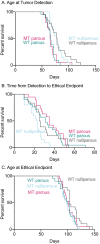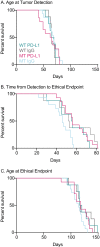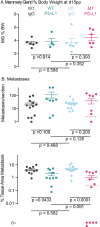Activation of the viral sensor oligoadenylate synthetase 2 (Oas2) prevents pregnancy-driven mammary cancer metastases
- PMID: 35505346
- PMCID: PMC9066770
- DOI: 10.1186/s13058-022-01525-z
Activation of the viral sensor oligoadenylate synthetase 2 (Oas2) prevents pregnancy-driven mammary cancer metastases
Abstract
Background: The interferon response can influence the primary and metastatic activity of breast cancers and can interact with checkpoint immunotherapy to modulate its effects. Using N-ethyl-N-nitrosourea mutagenesis, we found a mouse with an activating mutation in oligoadenylate synthetase 2 (Oas2), a sensor of viral double stranded RNA, that resulted in an interferon response and prevented lactation in otherwise healthy mice.
Methods: To determine if sole activation of Oas2 could alter the course of mammary cancer, we combined the Oas2 mutation with the MMTV-PyMT oncogene model of breast cancer and examined disease progression and the effects of checkpoint immunotherapy using Kaplan-Meier survival analysis with immunohistochemistry and flow cytometry.
Results: Oas2 mutation prevented pregnancy from increasing metastases to lung. Checkpoint immunotherapy with antibodies against programmed death-ligand 1 was more effective when the Oas2 mutation was present.
Conclusions: These data establish OAS2 as a therapeutic target for agents designed to reduce metastases and increase the effectiveness of checkpoint immunotherapy.
Keywords: Breast; Cancer; Immunotherapy; Interferon; Mammary; OAS2.
© 2022. The Author(s).
Conflict of interest statement
The authors declare that they have no competing interests.
Figures








References
-
- Nagato T, Lee YR, Harabuchi Y, Celis E. Combinatorial immunotherapy of polyinosinic-polycytidylic acid and blockade of programmed death-ligand 1 induce effective CD8 T-cell responses against established tumors. Clin Cancer Res. 2014;20:1223–1234. doi: 10.1158/1078-0432.CCR-13-2781. - DOI - PMC - PubMed
Publication types
MeSH terms
Substances
LinkOut - more resources
Full Text Sources
Medical
Molecular Biology Databases
Research Materials

